Blogs
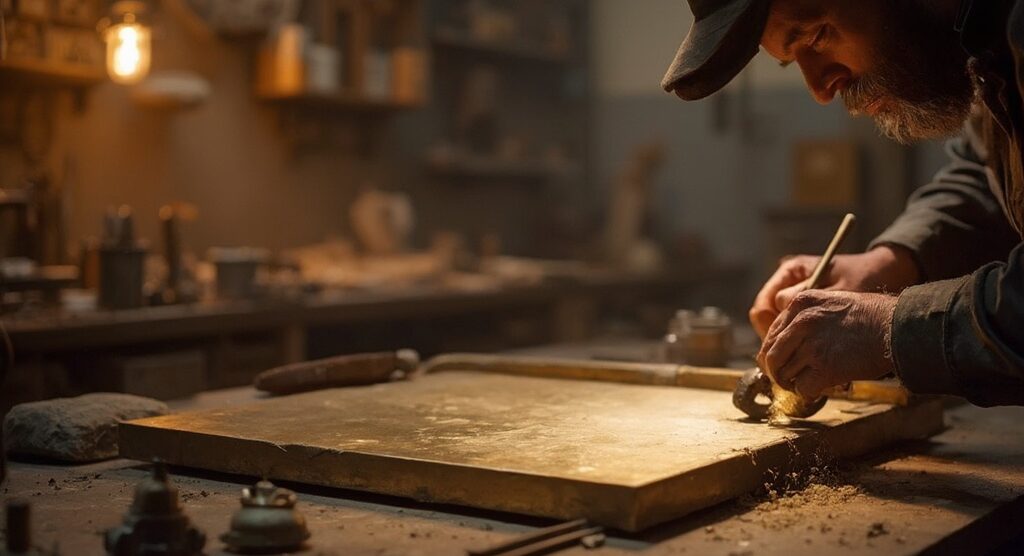
Understanding the Properties of Phosphor Bronze: A Complete Tutorial
Introduction
Phosphor bronze stands as a testament to the intersection of material science and practical application, combining the best attributes of copper, tin, and phosphorus to create an alloy that excels in diverse environments. Its unique properties, such as exceptional corrosion resistance and mechanical strength, make it a critical component in industries ranging from automotive to marine.
With a historical significance that extends beyond mere functionality, phosphor bronze not only enhances the durability and performance of products but also plays a vital role in cultural contexts, such as musical instruments and competitive awards.
As procurement managers navigate the complexities of sourcing materials, understanding the multifaceted advantages of phosphor bronze becomes essential for making informed decisions that align with strategic objectives and industry standards.
Fundamental Composition and Characteristics of Phosphor Bronze
Phosphor copper-tin is a mixture predominantly composed of copper and tin, with phosphorus content usually varying from 0.01% to 0.5%. The addition of phosphorus significantly enhances the properties of phosphor bronze, improving the metal’s strength and wear resistance, making this material a preferred choice across various manufacturing sectors. Notably, its distinct yellowish-golden hue and exceptional machinability are essential characteristics that procurement managers should factor into their sourcing decisions.
These traits, along with the properties of phosphor bronze, including its durability and corrosion resistance, make it particularly suitable for outdoor applications where environmental exposure is a concern. However, it is essential to note that phosphor alloy can develop ‘Disease,’ which leads to pale green spots due to reactions with oxygen and chloride, potentially impacting the material’s longevity. Additionally, manganese alloy, which can contain up to 3% manganese, offers a comparative perspective on the properties of different alloys.
Furthermore, the cultural significance of this metal is highlighted through its historical use in awards, such as medals in competitive sports, which symbolize achievement and recognize excellence. As Kat de Naoum observes, ‘The adaptability and sturdiness of this alloy make it a valuable option in diverse uses, showcasing both its practical advantages and cultural heritage.’ This connection underscores the material’s value and its integral role in various industries.
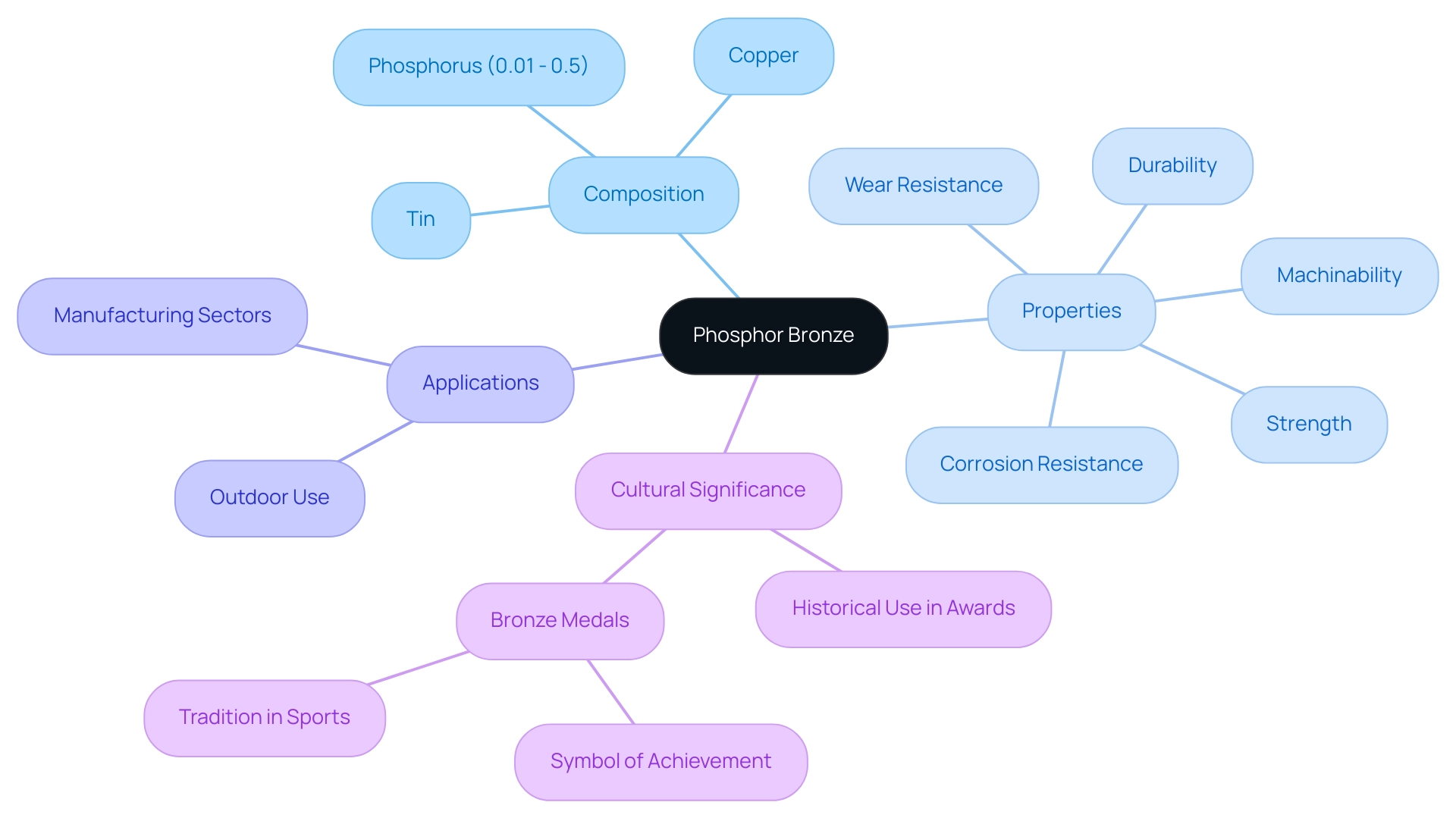
Key Properties: Corrosion Resistance and Electrical Conductivity
Phosphor alloy is renowned for its exceptional corrosion resistance, particularly in harsh environments such as seawater and atmospheric conditions, making it an ideal material for marine and outdoor applications. This alloy not only endures the challenges of exposure but also exhibits exceptional durability and longevity, guaranteeing that items created from this metal stay dependable over time. Additionally, phosphorescent copper alloy demonstrates excellent electrical conductivity, making it a favored option for electrical connectors and components.
Its conductivity is frequently favorably compared to other metals, increasing its attractiveness for various uses. A key point to consider is that while phosphor bronze, brass, and copper are all weldable, the ease of welding varies based on their specific alloys, which is crucial for manufacturing processes. In explosive environments, Non-Sparking Tools are a critical alternative, ensuring safety without compromising performance.
These tools are essential in fields such as oil and gas extraction, chemical processing, and mining, where traditional tools may pose ignition risks. The recent updates from RapidDirect, including an Instant Quote feature for Sheet Metal Fabrication, highlight the importance of staying informed about industry advancements that can streamline procurement. Furthermore, a case study named ‘Choosing Between Brass, Bronze, and Copper’ demonstrates how grasping these properties can greatly affect manufacturing choices, especially concerning durability, machinability, and particular requirements.
By aligning with the properties of phosphor bronze and these usage requirements, procurement managers can confidently utilize this material to enhance product performance and longevity, aligning with the strategic goals of modern procurement. Moreover, copper nickel alloys are widely utilized in marine engineering for components such as ship hulls, offshore platforms, and seawater piping systems. They surpass stainless steel in marine settings because of their exceptional corrosion resistance and thermal conductivity, rendering them perfect for heat exchangers and electrical uses.
With metal scoring between 40 and 420 on the Brinell hardness scale, it further highlights the material’s durability in challenging uses. Moreover, suppliers and producers of electrical insulation and high-temperature materials, including various papers, fabrics, and metals, play a crucial role in providing essential resources for these uses.
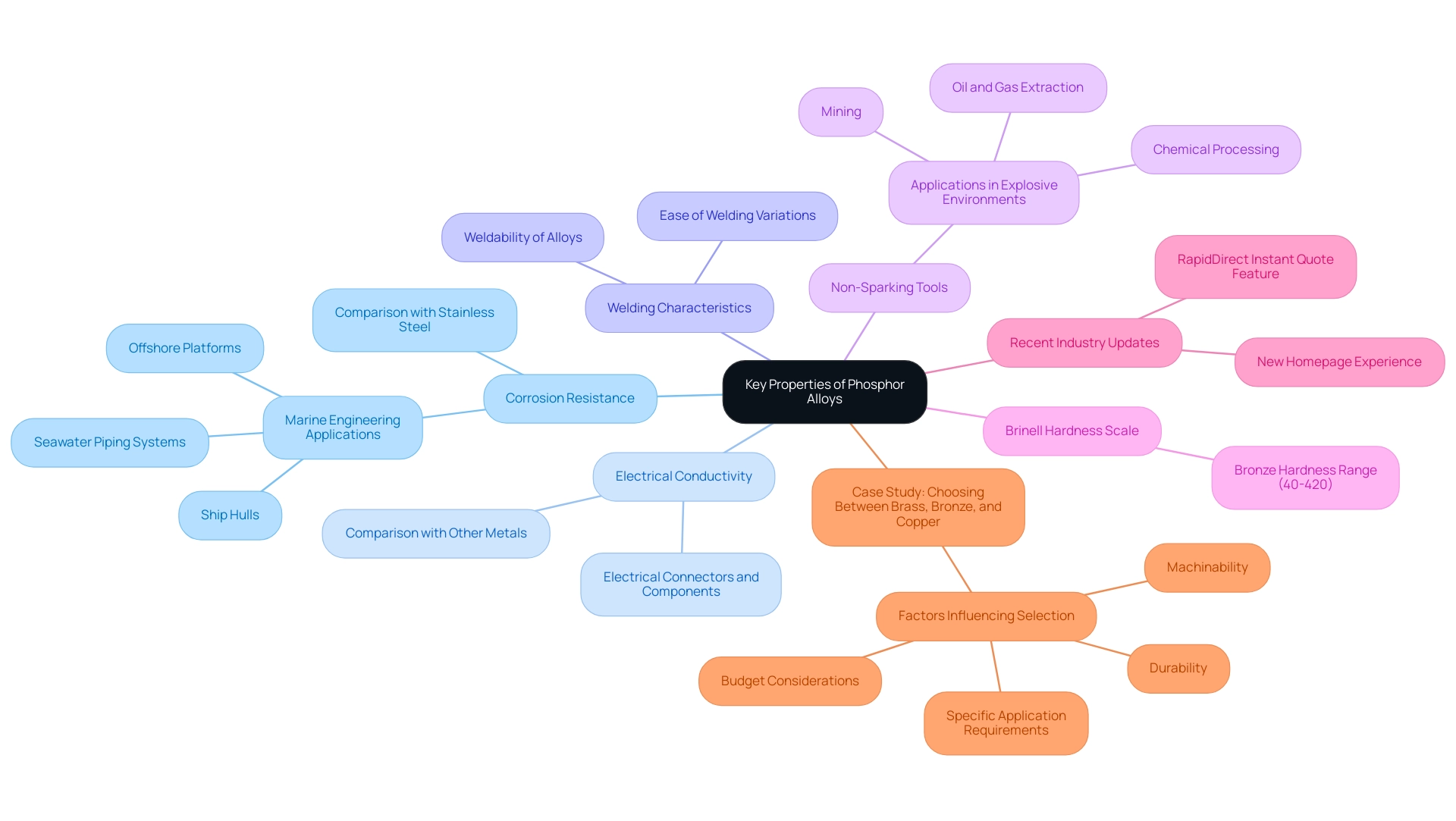
Mechanical Strength and Ductility of Phosphor Bronze
The remarkable mechanical strength of phosphor alloy is one of the key properties of phosphor bronze, enabling it to endure substantial loads without experiencing deformation. This mixture exhibits exceptional ductility, allowing for intricate shaping and forming without the risk of breakage, a quality that is indispensable in applications requiring complex geometries. The properties of phosphor bronze, which include a synergy of strength and ductility, are particularly vital for components subjected to continuous stress, such as springs and fasteners.
For instance, recent studies indicate that the mechanical strength of this alloy can reach levels comparable to some of the toughest materials, with toughness statistics suggesting that:
- Silicon has a toughness of 1
- Aluminum airframe alloys are around 35
- Some of the best steels reach about 100
This alloy stands out as a competitive option for manufacturers. By selecting a specific copper alloy, they can achieve an optimal balance between performance and manufacturability, while also leveraging the properties of phosphor bronze to ensure that the components meet design specifications and withstand challenging environments. As Robert Ritchie, a notable materials scientist, aptly observes, ‘the development and comprehension of substances such as a certain alloy are crucial for their efficient use,’ highlighting the continuous research and verification required in this area.
This underscores the key point that real-world uses may take years or decades to develop, emphasizing the importance of thorough validation in the use of phosphor alloys in demanding environments.
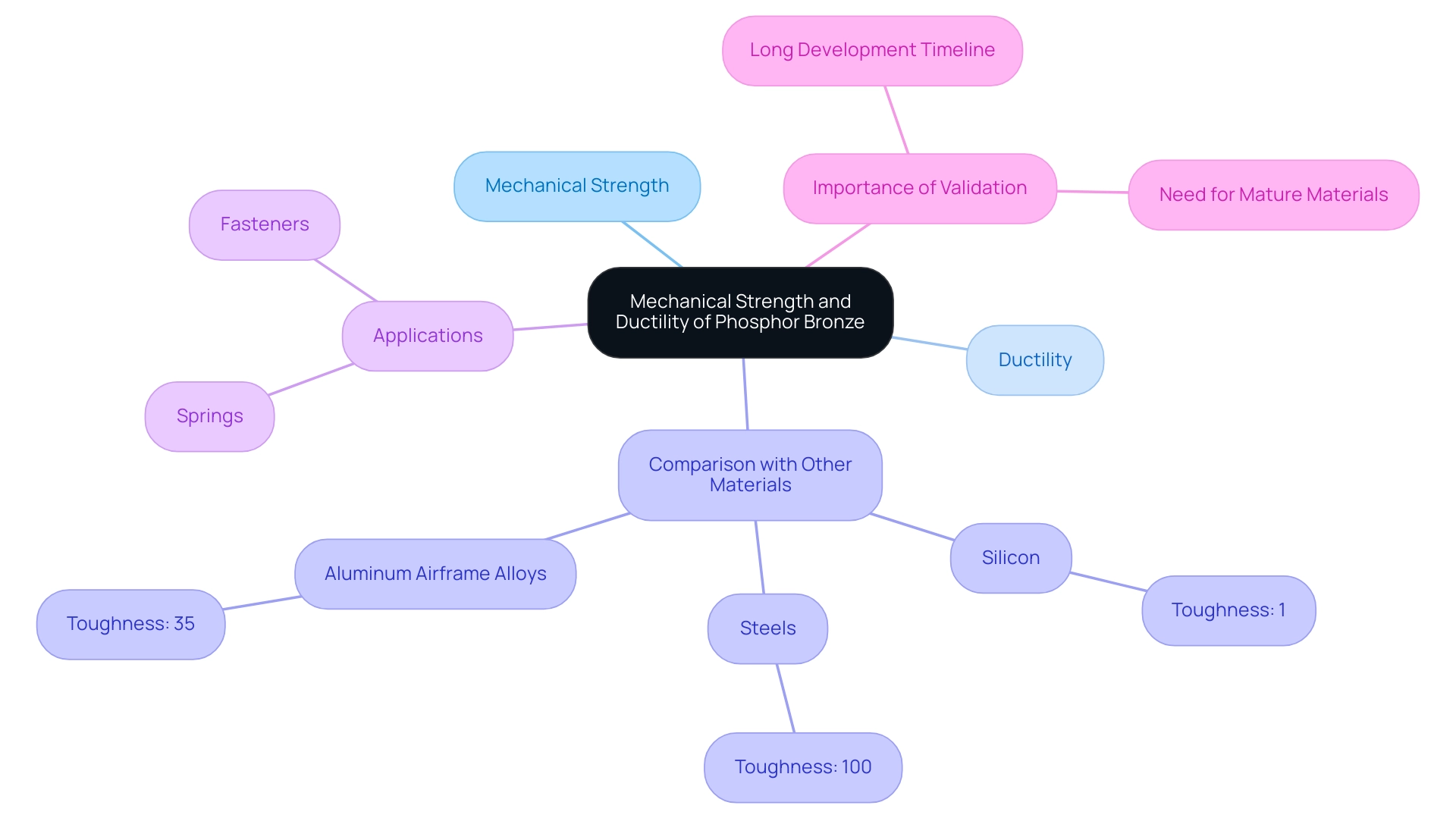
Applications of Phosphor Bronze in Various Industries
The properties of phosphor bronze make it extensively utilized in sectors such as automotive, electronics, and marine fields, where safety and dependability are essential. In automotive manufacturing, it is commonly found in components like:
- Gears
- Bearings
- Electrical connectors
These components ensure durability under demanding conditions. In the electronics sector, its excellent conductivity makes it ideal for:
- Connectors
- Circuit boards
These are vital for efficient performance.
Marine applications benefit from its corrosion resistance, making it suitable for:
- Ship fittings
- Hardware
Additionally, when working in explosive environments, integrating phosphor bronze with Non-Sparking Tools, which are specifically designed to prevent sparks that could ignite flammable materials, can significantly enhance safety measures. The diverse uses of the alloy highlight the properties of phosphor bronze, which are important in enhancing product durability and performance across various fields.
Moreover, high-temperature resistant materials such as Mica Tape products, recognized for their outstanding thermal and electrical insulation characteristics, are essential in scenarios demanding dependable safeguarding against heat and electrical dangers. Trusted suppliers of these materials provide essential solutions for industries prioritizing safety and performance.
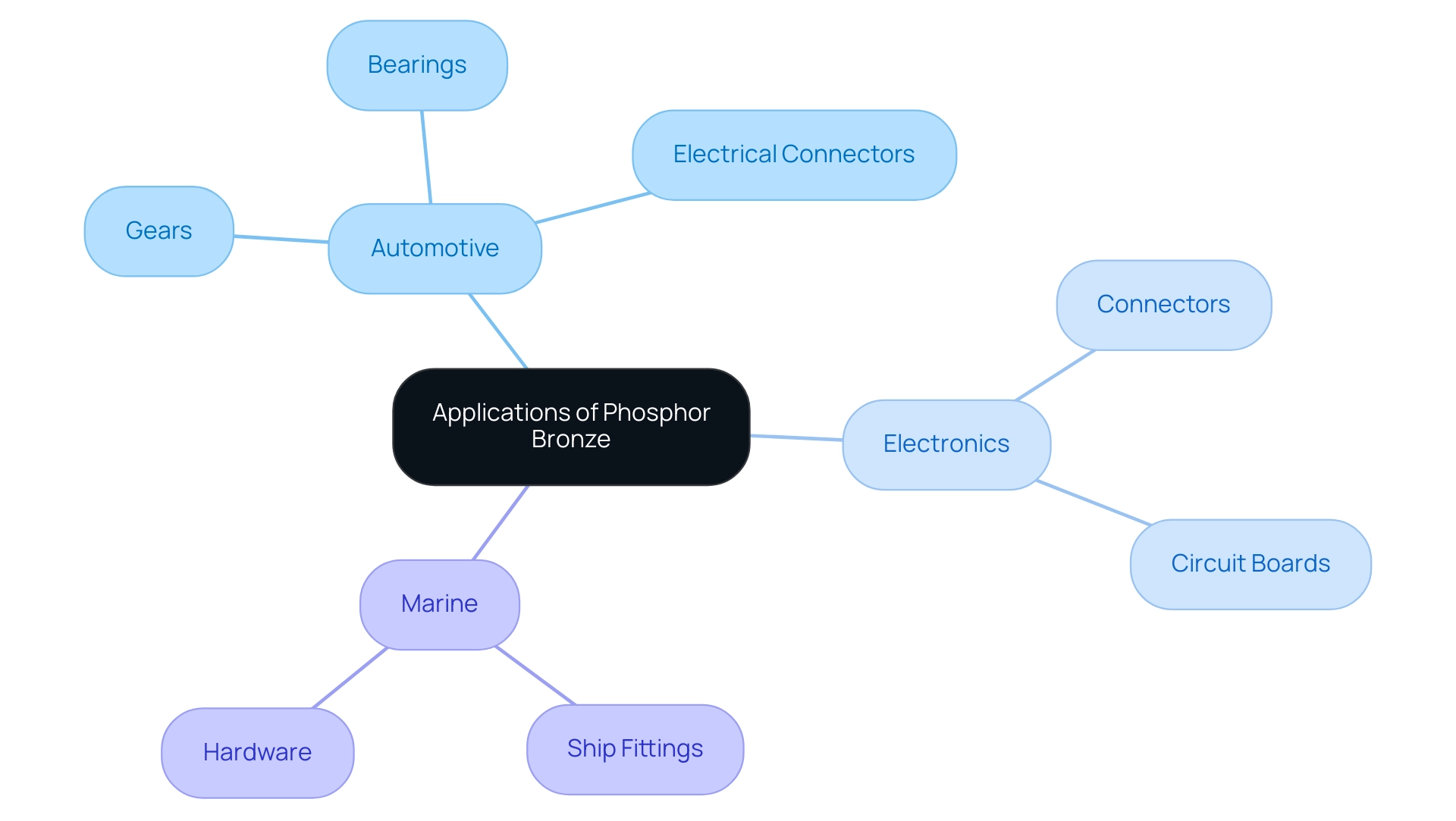
Specialized Uses: From Musical Instruments to Marine Components
Phosphor metal is famous for its specific uses across various sectors, especially in the area of musical instruments. Instruments like flutes and cymbals benefit from its exceptional tonal qualities, which are highly prized by musicians. In marine environments, phosphor bronze is utilized in critical components such as propellers, where its remarkable resistance to seawater corrosion ensures extended service life and reliability.
Moreover, it is a preferred selection for electrical connectors in high-performance uses, where both conductivity and durability are essential. These specialized uses not only underscore the alloy’s versatility but also its significant role in both artistic expression and functional performance. The chemical composition of PB102 phosphor bronze, which includes a weight percentage of tin between 4.50% and 5.50%, plays a crucial role in determining its properties and suitability for various applications.
As Taha Khan notes,
Researchers are already focusing on lead-free, self-lubricating bronze-bearing alternatives, and further advancements in this area are expected to minimize environmental impact in the near future.
However, challenges remain in developing these alternatives, emphasizing the importance of ongoing research and its implications for the industry.
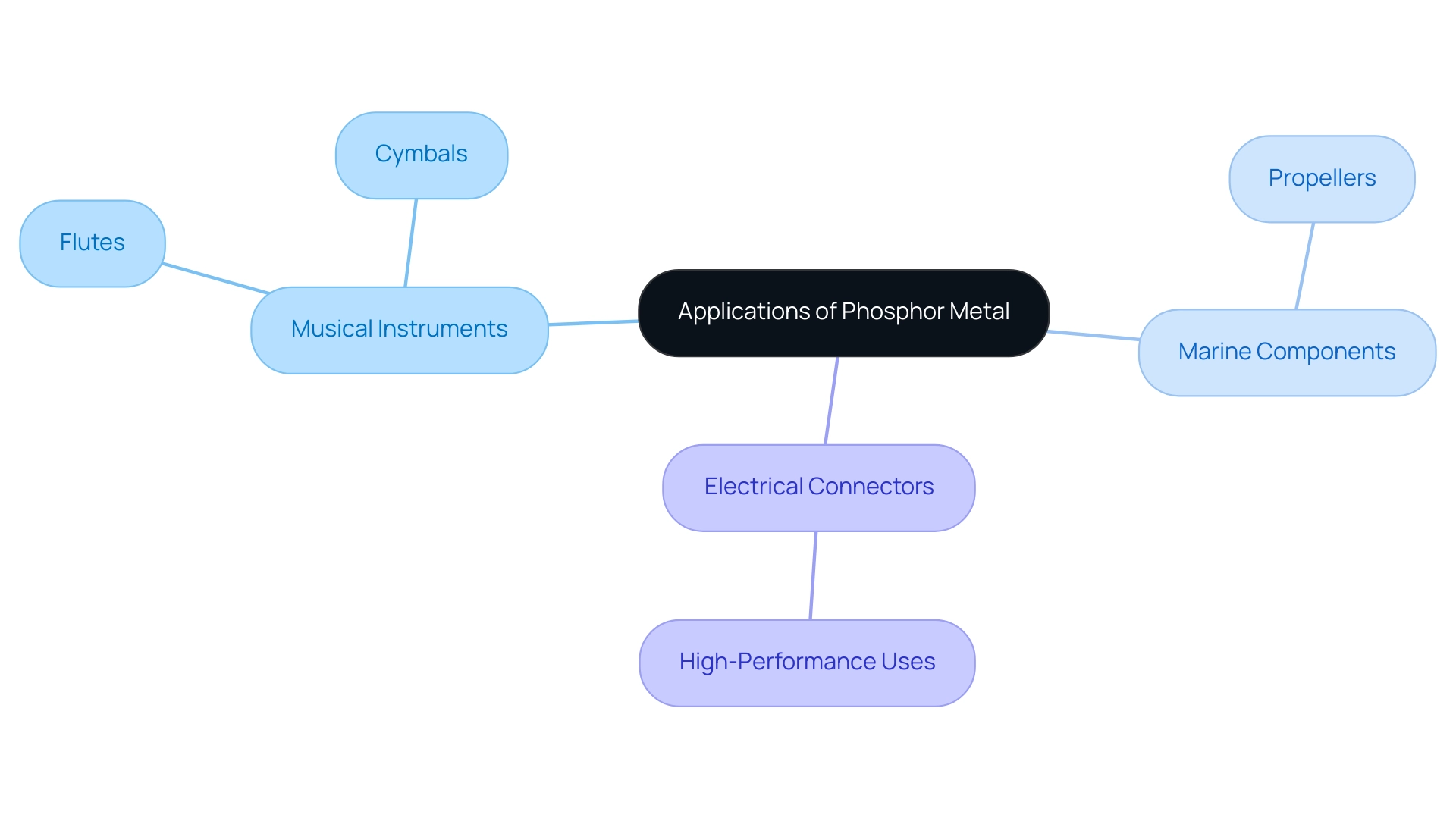
Conclusion
Phosphor bronze emerges as a crucial alloy, seamlessly blending strength, corrosion resistance, and versatility, making it indispensable across various industries. Its unique composition, predominantly featuring copper and tin with the enhancing presence of phosphorus, not only elevates its mechanical properties but also ensures its reliability in demanding environments. From automotive components to marine applications, the alloy’s durability and exceptional performance underscore its strategic importance in manufacturing processes.
The remarkable attributes of phosphor bronze, such as its resistance to corrosion and excellent electrical conductivity, position it as a preferred choice for critical applications. Its mechanical strength and ductility further allow for intricate designs and reliable performance in products ranging from electrical connectors to musical instruments. The multifaceted benefits of this alloy resonate strongly in sectors where safety and efficiency are paramount, highlighting its integral role in enhancing product longevity and operational effectiveness.
As industries continue to evolve, the understanding of phosphor bronze’s properties and applications remains vital for procurement managers. Leveraging this knowledge not only aids in informed sourcing decisions but also aligns with broader strategic goals. In a landscape where performance and sustainability are increasingly prioritized, phosphor bronze stands out as a material that not only meets the demands of today but also paves the way for innovative solutions in the future.




